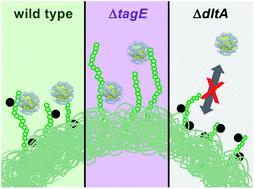当前位置:
X-MOL 学术
›
Chem. Sci.
›
论文详情
Our official English website, www.x-mol.net, welcomes your
feedback! (Note: you will need to create a separate account there.)
Wall teichoic acids govern cationic gold nanoparticle interaction with Gram-positive bacterial cell walls
Chemical Science ( IF 7.6 ) Pub Date : 2020-03-23 , DOI: 10.1039/c9sc05436g Emily R Caudill 1 , Rodrigo Tapia Hernandez 2 , Kyle P Johnson 3 , James T O'Rourke 1 , Lingchao Zhu 4 , Christy L Haynes 3 , Z Vivian Feng 2 , Joel A Pedersen 1, 5, 6, 7
Chemical Science ( IF 7.6 ) Pub Date : 2020-03-23 , DOI: 10.1039/c9sc05436g Emily R Caudill 1 , Rodrigo Tapia Hernandez 2 , Kyle P Johnson 3 , James T O'Rourke 1 , Lingchao Zhu 4 , Christy L Haynes 3 , Z Vivian Feng 2 , Joel A Pedersen 1, 5, 6, 7
Affiliation

|
Molecular-level understanding of nanomaterial interactions with bacterial cell surfaces can facilitate design of antimicrobial and antifouling surfaces and inform assessment of potential consequences of nanomaterial release into the environment. Here, we investigate the interaction of cationic nanoparticles with the main surface components of Gram-positive bacteria: peptidoglycan and teichoic acids. We employed intact cells and isolated cell walls from wild type Bacillus subtilis and two mutant strains differing in wall teichoic acid composition to investigate interaction with gold nanoparticles functionalized with cationic, branched polyethylenimine. We quantified nanoparticle association with intact cells by flow cytometry and determined sites of interaction by solid-state 31P- and 13C-NMR spectroscopy. We find that wall teichoic acid structure and composition were important determinants for the extent of interaction with cationic gold nanoparticles. The nanoparticles interacted more with wall teichoic acids from the wild type and mutant lacking glucose in its wall teichoic acids than those from the mutant having wall teichoic acids lacking alanine and exhibiting more restricted molecular motion. Our experimental evidence supports the interpretation that electrostatic forces contributed to nanoparticle–cell interactions and that the accessibility of negatively charged moieties in teichoic acid chains influences the degree of interaction. The approaches employed in this study can be applied to engineered nanomaterials differing in core composition, shape, or surface functional groups as well as to other types of bacteria to elucidate the influence of nanoparticle and cell surface properties on interactions with Gram-positive bacteria.
中文翻译:

壁磷壁酸控制阳离子金纳米颗粒与革兰氏阳性细菌细胞壁的相互作用
对纳米材料与细菌细胞表面相互作用的分子水平理解可以促进抗菌和防污表面的设计,并为评估纳米材料释放到环境中的潜在后果提供信息。在这里,我们研究了阳离子纳米颗粒与革兰氏阳性菌的主要表面成分:肽聚糖和磷壁酸的相互作用。我们采用完整的细胞和来自野生型枯草芽孢杆菌的分离细胞壁以及壁磷壁酸成分不同的两种突变菌株来研究与用阳离子支链聚乙烯亚胺功能化的金纳米颗粒的相互作用。我们通过流式细胞术量化了纳米颗粒与完整细胞的关联,并通过固态31 P-和13 C-NMR 光谱确定了相互作用位点。我们发现壁磷壁酸的结构和组成是与阳离子金纳米颗粒相互作用程度的重要决定因素。与壁磷壁酸缺乏丙氨酸并表现出更受限制的分子运动的突变体相比,纳米颗粒与其壁磷壁酸中缺乏葡萄糖的野生型和突变体的壁磷壁酸相互作用更多。我们的实验证据支持这样的解释:静电力有助于纳米颗粒-细胞相互作用,并且磷壁酸链中带负电的部分的可及性影响相互作用的程度。本研究中采用的方法可应用于核心组成、形状或表面官能团不同的工程纳米材料以及其他类型的细菌,以阐明纳米颗粒和细胞表面特性对与革兰氏阳性菌相互作用的影响。
更新日期:2020-03-23
中文翻译:

壁磷壁酸控制阳离子金纳米颗粒与革兰氏阳性细菌细胞壁的相互作用
对纳米材料与细菌细胞表面相互作用的分子水平理解可以促进抗菌和防污表面的设计,并为评估纳米材料释放到环境中的潜在后果提供信息。在这里,我们研究了阳离子纳米颗粒与革兰氏阳性菌的主要表面成分:肽聚糖和磷壁酸的相互作用。我们采用完整的细胞和来自野生型枯草芽孢杆菌的分离细胞壁以及壁磷壁酸成分不同的两种突变菌株来研究与用阳离子支链聚乙烯亚胺功能化的金纳米颗粒的相互作用。我们通过流式细胞术量化了纳米颗粒与完整细胞的关联,并通过固态31 P-和13 C-NMR 光谱确定了相互作用位点。我们发现壁磷壁酸的结构和组成是与阳离子金纳米颗粒相互作用程度的重要决定因素。与壁磷壁酸缺乏丙氨酸并表现出更受限制的分子运动的突变体相比,纳米颗粒与其壁磷壁酸中缺乏葡萄糖的野生型和突变体的壁磷壁酸相互作用更多。我们的实验证据支持这样的解释:静电力有助于纳米颗粒-细胞相互作用,并且磷壁酸链中带负电的部分的可及性影响相互作用的程度。本研究中采用的方法可应用于核心组成、形状或表面官能团不同的工程纳米材料以及其他类型的细菌,以阐明纳米颗粒和细胞表面特性对与革兰氏阳性菌相互作用的影响。











































 京公网安备 11010802027423号
京公网安备 11010802027423号